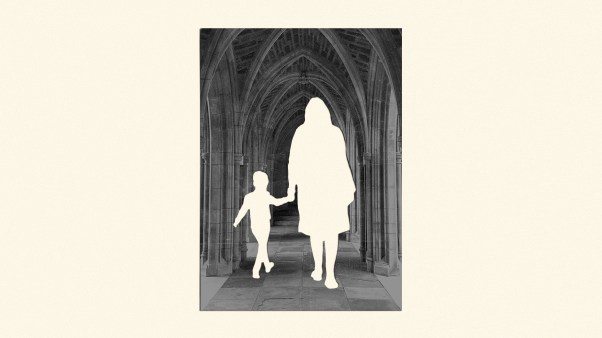About a decade ago, a friend of mine mentioned a series of videos about the Bible he’d discovered online. It was by an obscure Canadian academic whom neither of us knew. My friend had been raised evangelical and remained a Christian, but after watching, he asked me a question he’s repeated many times since: “Why didn’t anyone ever tell me the Bible is interesting?”
That question is the right point of entry for considering how that Canadian academic, Jordan Peterson, has since catapulted into worldwide fame. His YouTube channel has more than eight million subscribers. His podcast boasts millions of downloads. His books are bestsellers. Politicians know his name, hostile publications wield it like a club, and guests on his show have ranged from Richard Dawkins, Roger Scruton, and Naftali Bennett to Ayaan Hirsi Ali, Glenn Greenwald, and Bishop Robert Barron.
Peterson’s rhetorical style is muscular, assertive, and unapologetic. He has therefore assumed the role of conservative culture warrior. But the moniker has always rung somewhat hollow given his training and sensibilities. Peterson is a Jungian psychologist who taught at Harvard and Toronto; who believes simultaneously, and apparently with equal intensity, in the truths of evolutionary biology and the truths of Christian Scripture; and who calls himself an old-school liberal and swears he lacks the competence necessary to know, for instance, whether Jesus rose bodily from the dead or even what that would mean.
An odd ally for Christians, in other words, at least at first glance. Yet my Christian friend found Peterson a breath of fresh air. The reason, I’ve come to see, is simple. Peterson was speaking about the Bible as if it were the most important thing in the world, as if the stakes were a matter of life and death, as if the stories and themes of Scripture demanded an immediate existential decision on the part of everyone who encountered them. My friend was familiar with old-time religion. He wasn’t familiar with this.
In Peterson’s new book, We Who Wrestle with God: Perceptions of the Divine, readers curious about what drew in my friend—and so many like him—can see for themselves what the fuss is about.
The volume is, to put it mildly, an enormous undertaking—quite unlike Peterson’s self-help books. Running more than 200,000 words, it is a thematic and allegorical commentary on the law of Moses, especially Genesis and Exodus. It is gargantuan in every sense of the word: energizing and exhausting, brimming with ideas and asides, full of insightful connections and baffling conclusions, consistent in its viewpoint, maddening in its dodges, impressive in its ambition, and tedious, at times, in its sheer funereal solemnity.
Now, about those other books: In what follows, I am going to assess this volume and nothing else. Unlike my friend, I don’t belong to the Peterson fandom. In preparation for this review, I’ve listened to a couple episodes of his podcast and watched a few clips. Beyond that, this book was, for me, what I expect it will be for many others: a first-time immersion in the mind of Jordan Peterson.
Allegory, archetypes, and anthropology
Ever since Paul described the story of Hagar and Sarah as an allegory (Gal. 4:24), Christians have read the stories of the Old Testament in ways that reach beyond the literal and historical. And as long as they have done so, they’ve argued about how best to do it. Early on, under the influence of pastors and scholars like Irenaeus of Lyons, Origen of Alexandria, and Augustine of Hippo, a loose, shared approach arose that continued to develop into the late Middle Ages.
You could call it allegory, but it was also known as figuralism, typology, or the spiritual sense. The idea was that historical figures and events pointed beyond themselves to the coming of Christ and his church. God authored the events of salvation history itself as much as its transcription in Scripture, so that the first Adam pointed to the second, Eve pointed to Mary, and so on. The human and historical reality was not erased but confirmed and upheld in this providential correspondence. As Jesus said, “If you believed Moses, you would believe me, for he wrote about me” (John 5:46).
For medieval readers like Thomas Aquinas, the literal sense of the text was bedrock. The words of a passage had a plain meaning—on the surface, so to speak—and this was the primary significance for which readers should search. But building on the literal, the spiritual sense unfolded in three ways: the allegorical, indicating the saving realities of the new covenant; the tropological, indicating how believers should live morally; and the anagogical, indicating the glory to be revealed at the end of all things.
Why this history lesson in biblical hermeneutics? Because Peterson’s book is nothing if not a full-throated allegory of the first five books of the Bible (plus Job and Jonah). Yet he does not deploy the full medieval interpretive scheme. He reads the Bible exclusively for its moral (or tropological) sense, filtered through an anthropological and psychological lens.
In Peterson’s hands, this sense is usually divorced both from the historical aspect of the literal sense (namely, whether an event “really” occurred) and from its fulfillment in the passion of Christ and Pentecost. The Bible is revelatory, for Peterson, but what it reveals is human perseverance in the face of the world’s evil, terror, and potential to induce despair.
One term for this approach would be anthropocentric. A more generous description would see it as a “bottom-up” movement, from the human to the divine, which doesn’t have to preclude the “top-down” approach, from God to humanity. Either way, the intent is not a denial of biblical truth. It’s a redefinition of what it means to describe the Bible as true in the first place.
The value of Scripture, in Peterson’s eyes, is its preservation of deep mythic realities that cannot be told except by means of symbol, archetype, and story. In a word, the canon is a vast library or reservoir of what he calls “meta-truths” rendered in narrative form. For example, he describes the story of Cain and Abel as “a meta-truth—a frame within which the facts of the world are held to reveal themselves; a structure that defines all the truths [that we] are capable of seeing and of acting on.”
Given the antiquity and strangeness of Scripture’s mythic archetypes, Peterson thinks modern readers, religious or otherwise, lack the eyes to see what’s going on in its stories. Reading nonsymbolically, he argues, is inadequate to how Scripture is meant to communicate. Biblical truths cannot be comprehended except by stories, and these truths are so vital that in their absence our lives, values, institutions, and civilization itself cannot survive for long.
Truth, narrative, and fairy tales
Let me give you the flavor of Peterson’s way of reading. Typically, he begins by summarizing a biblical story, drawing attention to notable details or oddities in the text. Then he asks a variant of a question he repeats countless times: “What does this mean?” “What does this signify?” “What is the moral of the story?” The book is a catalogue of his many answers.
His moral of the binding of Isaac, for example, is that “all things, no matter how valuable, must be offered up to God.” As for the Israelites’ plundering of the Egyptians, the moral is that “those who abide by the proper faith will end up with everything, even that which the tyrants have attempted to sequester.” The moral of the Tower of Babel: “The arrogant belief in the power of technology … corrupts the entirety of psyche and state so completely that words themselves … lose their meaning.” The moral of Genesis 3: “Do not ascribe to yourself the right to question the minimal necessary preconditions for harmonious being established by what is truly transcendent—or all is lost.”
On its own terms, Peterson’s exegesis can be quite successful. His meditations on cycles of violence in Cain and Abel and on the technological temptation in Babel are illuminating. I was moved and instructed by his interpretation of Eve’s special role as ezer kenegdo: “a beneficial adversary—a partner in play.” And Peterson’s favorite conversation partners, including Fyodor Dostoevsky, Aleksandr Solzhenitsyn, John Milton, and Mircea Eliade, make for a wonderful conversation with Moses, not least since they too were close readers of the canon.
Yet a fundamental ambiguity hangs over the entire book. Peterson does not claim to be a Christian, at least in the ordinary sense. Has he inadvertently reduced Jews and Christians’ sacred Scriptures to morals and tropes, thereby eliminating not just the literal and the historical but the metaphysical as well?
To use Peterson’s own words, does he see Scripture as nothing more than “the landscape of the fictional,” an imaginative symbolic space “where we experiment with value, while remaining secure”? When he calls Jonah and other scriptural stories the “deepest of all fairy tales,” is this akin to C. S. Lewis’s notion of “true myth”—as Peterson seemed to intimate a few years ago? Or is the Bible on a spectrum with Homer and Grimm and Walt Disney, different by the degree to which it manifests deep human truths, but not different in kind?
The great danger, which I expect Peterson wants to avoid, is that his method threatens to make the Bible just one more (if the best) book of rules for life.
Israel, revelation, and God
Let me close with five observations: two notes of appreciation and three of caution.
First, the world does not need fewer commentaries on the Torah but more, always more. Jews and Christians alike should therefore give thanks that Peterson has joined Marilynne Robinson, Robert Alter, Leon Kass, Avivah Gottlieb Zornberg, and other students of literature and politics in turning to the five books of Moses as the beginning of our tutelage in divine wisdom.
Second, the power of Peterson’s style is his marriage of existential urgency with hermeneutical creativity. He expects the Word to show him wonders. He wrestles with the text—a mystery and a stranger—until he secures a blessing from it. He takes for granted that its depths are bottomless. Do pastors model this posture in the pulpit? Do teachers in the classroom? Do scholars on the page?
Christian readers should learn from Peterson’s boldness, his disposition of awe and docility before the sacred page. He opens the scroll with the same spirit as the psalmist: “Open my eyes that I may see wonderful things in your law” (119:18). Moreover, believers who have retreated from symbolic and spiritual interpretations into the literal alone should return to the wisdom of patristic and medieval interpreters, who were themselves following the example of Christ and the apostles. The Old Testament is full of signs and wonders. Make the Bible interesting again.
That said, I conclude with cautions. To begin, the risk of Peterson’s method is neither eisegesis nor atheism but an unintended supersessionism. Peterson doesn’t argue that God annulled his election of the Jews by replacing them with the (mostly Gentile) church. He would never dream of eliminating the Jewishness of the Law and the prophets.
But something similar inevitably occurs whenever Gentiles read Israel’s Scripture as a collection of religious tales about humanity in general, for it is anything but. It is about the particular man Abraham, his wife Sarah, and their many children. It is not about “Everyman.” It is about the promise of the one God to this one people. It may be about more than this, but not less.
Second, the question of God is unavoidable. Peterson is slippery on this point. Familiar words from Christian doctrine—like creation and redemption and resurrection—mean something altogether different when Peterson uses them. At the end of the day, the atheist Richard Dawkins is right to press the point: Was the tomb of Jesus empty? Did he walk on water? Is God a living, personal reality who alone created and sustains the world? Who became incarnate in Jesus of Nazareth? Who inspired and speaks through Holy Scripture?
Peterson doesn’t answer—or when he does, it’s by code-switching back into the language of psychology, myth, and archetypes. This isn’t necessary. Theologians can speak Peterson’s dialect; it seems reasonable to ask him to return the favor.
If he tried, he might discover that he need not leave behind his moral interpretive method. Rather, it would be strengthened through reintegration with the other senses of Scripture. The Bible does indeed possess “wisdom from time memorial,” as Peterson puts it. But this is not (only) because it hands on the compressed mythic insights of antiquity but because it is the very Word of God.
Finally, a specter haunts this book: the specter of Protestant liberalism. Prominent in the West over the last two centuries, this movement has also read the Bible through a human-focused lens. It has shucked the shell of myth and miracle, seeking the moral kernel within.
That kernel was the brotherhood of man, a this-worldly message of social uplift and political progress. It turns out, though, that when the church is reduced to a vaguely spiritual charity or activism club, it loses its reason for being. A godless gospel is scarcely worth living for, much less dying for. An unrisen Christ is no Christ at all.
I should add that the best of the Protestant liberals were brilliant scholars, devoted students of Scripture, and pious lovers of Jesus. In his own way, Peterson is one of them. Yet it is difficult to tell whether that is where he wants to be.
And curiously, whereas Protestant liberalism stood at the church’s doors ushering believers out, Peterson stands in the same threshold, ushering unbelievers in (and sometimes shooing drifting believers back in!). For this reason he may well be counted among the new “digital lectors” schooling the curious and the uncatechized in this rising generation that lives and learns online. His influence on my friend is shared by thousands of others, and for that we Christians should be grateful.
But we should insist it’s not enough. The man stands at the threshold. A voice within beckons. It says, “Take and read; take and read!” It says, “The fear of the Lord is the beginning of wisdom” (Prov. 9:10). It says, “I am the First and the Last. I am the Living One; I was dead, and now look, I am alive for ever and ever!” (Rev. 1:17–18). It says, “What is that to you? You must follow me” (John 21:22).
Peterson is lingering just outside the church, theologically lukewarm, secure in his insecurity, a friend to seekers but not to the friend of sinners. Our prayer should be that Christ would draw him to step inside. Physician, heal thyself! Let the one who helps others be helped. Let the man cross the threshold through the venture of faith and see what he discovers within.
Brad East is an associate professor of theology at Abilene Christian University. He is the author of four books, including The Church: A Guide to the People of God and Letters to a Future Saint.























